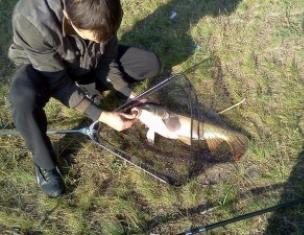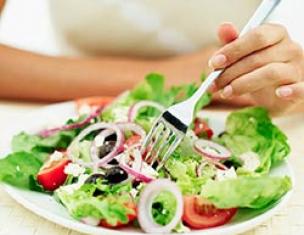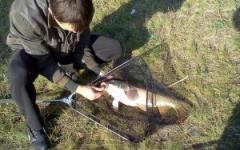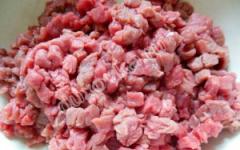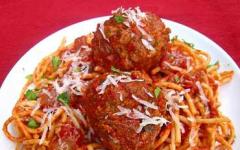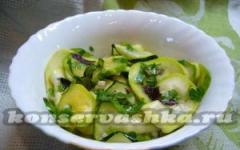How to cook tasty pilaf I found out being in Ukraine. But I tried the most delicious pilaf in my life in Uzbekistan, in the picturesque city of Samarkand, where on holidays huge cauldrons smoke on the streets and attract the smell of this tasty food.
My pilaf is far from Uzbek, but tasty is for sure. At the end of the article, the famous Stalik Khankishiyev will show his master class, watch and enjoy!
To make pilaf, we need:
- 1kg of meat (suitable for lamb, pork, beef);
- a glass of vegetable oil;
- 1kg of rice;
- 4 large onions (about a pound);
- 4 large carrots (also about 500 g);
- zira (can be replaced with ordinary cumin, a bag of 12-15 grams);
- a glass of dried barberries;
- half a cup of raisins;
- a pair of garlic heads;
- 10-15 black peppercorns, bay leaf (optional);
- salt.
My hands, we begin to cook.
To cook delicious pilaf, you need appropriate utensils - an aluminum or cast-iron cauldron with a rounded bottom of at least 6 liters. Pour a glass of oil into it, set on high heat.
While the oil is heating up, in some dishes we wash the rice and soak it in warm water:


The best for pilaf are, as they are called, vitreous varieties that retain the grain shape when cooked, but if there is none, any quality rice will do, I used basmati.
Cut the meat into pieces the size of a plum. We throw a pinch of salt into the cauldron, if the oil has then started to crackle, it means that it is well heated and you can add meat, put it in, mix it.

We bring the meat to such a state, when all its juice from the cauldron will evaporate, and the meat in oil will begin to brown. Until this happens, chop the onion into large strips:

Rub the whole carrot on a coarse grater, but if it’s absolutely correct, then you need to cut it into strips:

And in a separate kettle bring water to a boil.
As soon as the meat reached the desired condition:

I take it out for a while, and in the remaining oil I fry the onion until golden brown.

Then I add carrots and I also fry slightly, for about 5 minutes. Then pour raisins, barberries, cumin (cumin) in a cauldron, I put more pepper and bay leaf.

Spread back the meat.

All this (zirvak) is poured boiling water until it begins to be covered with water.

I still put a couple of garlic heads, right in the whole kind, unpeeled, just washed.

Bring to a boil and simmer on low heat for 30-40 minutes. Good zirvak - a pledge of delicious pilaf. After some time, add salt (about half a tablespoon).
We try, if the carrot is stale - order. The taste of the whole mass should be slightly salty, because rice will take some of the salt for itself. Salt if necessary.
The final stage is to pour water out of the rice, carefully lay out the rice with a spoon evenly over the entire surface of the cauldron:

Fill with boiling water (gently trickle) so that the rice is covered with about 15-20 mm water.

Starts to boil - make the smallest fire, cover with a lid. In no case can not mix rice.
After 15-20 minutes, the rice will absorb the water, wait a little more.

We try, if the rice is almost cooked, we make a hole in the rice with a stick and see if the water has gone far. If near the surface - wait for it to evaporate.
If rice is not cooked, and the water is evaporated - gently pour boiling water. If the rice is almost ready, the water is almost gone - carefully collect the rice to the center of the slide, make several holes for the steam to come out.

Turn off the fire, cover the cauldron with a towel, and on top - with a lid, and let it brew.

Thus, the evaporated moisture will not condense on the lid and drip into the cauldron, but be absorbed into the towel.
So you learned how to cook delicious pilaf, fragrant, delicious ...

Pilaf is heavy food. It is advisable not to drink alcoholic beverages to it, green tea is most suitable.
And now look how the master cooks plov.
Pilaf refers to the dishes eastern cuisineon your own taste features He is quite hearty and colorful. The original recipe of this dish has several variations, so that in each country the dish is prepared differently. Consider the most common cooking recipes.
Classics of the genre
An important feature of cooking pilaf for this recipe is the correct choice of rice. For this technology, semi-soft varieties are not suitable, give preference to hard grain rice (Devzira, Laser, Alanga).
As for meat, pilau is cooked in Tashkent from lamb or beef. According to original recipe Cotton oil should be used, but in some cases it is replaced with ordinary sunflower oil.
- rice - 650 gr.
- beef (lamb) - 650 gr.
- natural oil (cotton, vegetable) - 100 ml.
- chilli pepper - 2 pcs.
- yellow onion - 4 pcs.
- garlic - 1 head
- carrots - 500 gr.
- adjika ground (dry) - 5 gr.
- zira - 10 gr.
- seasoning for pilaf
- Wash and peel the carrots, chop them into cubes, chop the paprika into thin strips, onions - half rings, lamb or beef - into small cubes of 4 * 4 cm
- Take a cauldron or a thick-bottomed frying pan, put on a large fire, pour cotton oil (sunflower oil) and warm it up to the maximum possible threshold. When this happens, add onion half rings, fry them until golden brown in boiling oil.
- After the onions are roasted, add cubes of meat to it, reduce the heat to the middle mark and deep-fry. You need to bring the meat to such a state that it grabs the crust, while leaving the juice inside. Do not bring to readiness, in the process of cooking it will reach itself. After the term of roasting the meat, send cubes of carrot to the cauldron, poke it, constantly stirring.
- Peel the garlic, cut into small pieces 3 cloves of garlic, mix with zira, spices for pilaf and salt. Send the contents to the rest of the ingredients, add a little water so that the liquid covers the composition. Tomit on low heat for about half an hour, then open the lid and wait until the water has partially boiled away.
- While the foundation is languishing on the fire, proceed to the processing of rice. Rinse it under running water 7-8 times so that the drained liquid becomes completely transparent. Next, fill the grain with boiling water so that the liquid level rises 1 cm, cover with a lid and leave for a quarter of an hour.
- After infusing the rice, place the chopped garlic on top of the cauldron, press it with a spatula, and place a thick layer of rice. Then again garlic and rice. When all the grains are laid out, cover the lid, cover with water, stew for about 10 minutes.
- At the end of the period, collect the rice from the walls to the middle of the tank, open the cauldron and allow the liquid to boil off. After all the water has evaporated, cover the pan, reduce the heat, leave the compound to soak for another 20 minutes.
In the end, you should have crumbly steamed rice without damaged grains. Serve the dish with a salad of vegetables and cheese, and supplement it with green tea with jasmine or melissa.
![]()
- rice (steamed) - 750 gr.
- white onion - 3 pcs.
- carrots - 2 pcs.
- tomatoes - 4-5 pieces (at the discretion of)
- garlic - 1 head
- pork or lamb (pulp) - 650 gr.
- olive oil - 175 ml.
- spice
- Cut the onion into half rings, chop the carrot into strips or thin slices. Heat the cauldron well, fry the vegetables until they are half cooked. After that, chop the meat into cubes, fry it over medium heat so that the juice comes out.
- Rinse the rice seeds under running water several times, then place them in a dense layer on top of the fried onions, carrots and meat. Peel and chop the garlic, stick it into the rice, fill the contents with purified water mixed with spices.
- Cover with a lid, simmer for about half an hour so that the water partially boils away. When this happens, place the cubes of tomatoes on the surface, do not mix, refill with liquid.
- Wait 20 minutes, during which time the water should evaporate. Collect rice from the walls to the center of the container to form a peculiar slider. Cover with a lid, turn down the heat to the minimum mark, simmer another quarter of an hour.
People who, for certain reasons, do not eat meat, have to look for alternative ways to make pilau. Since tender fish fillet undergoes heat treatment in a short time, it is better to use a slow cooker or steamer.

- boneless sea fish (fillet portion) - 400 gr.
- rice "Alanga" or "Laser" - 450 gr.
- sour cream with fat content from 20% - 300 gr.
- onion - 2 pcs.
- vegetable oil - 50 ml.
- carrots - 1 pc.
- dill, parsley
- seasoning for pilaf
- Wash the fish, dry it with a waffle or paper towel, chop it into small cubes or slices.
- Cut the onion into rings. Fry it in a slow cooker until golden brown, after adding vegetable oil. Choose the appropriate mode "Express" or "Hot".
- When the onion rings are ready, rub the carrot on a grater with a large section. Send it and fish fillets to the rest of the ingredients, cook until golden brown (10-15 minutes). During the whole period, pause the device and stir the contents so that all components are roasted evenly.
- Rinse the rice through a colander 8-10 times, soak it for 15 minutes in boiling water. Mix sour cream with spices, add chopped parsley and dill.
- When onions, meat and carrots come to a state of readiness, put rice on top of them and season with sour cream mixture, mix, set the mode of “Quenching”, “Krupa” or “Kasha” (depends on the manufacturer of the multicooker / steamer).
- Wait for the timer to turn off, then do not open the lid, leave the dish to ripen for another half an hour. Before serving, drizzle the juice with lemon juice mixed with soy sauce.
Many prefer chicken fillet mutton (beef, pork) tenderloin, and it is not surprising. Quick recipe cooking does not require a lot of effort, the chicken easily soaks the rice grains, so that the dish is tender.

- chicken fillet or breast - 550 gr.
- steamed rice - 600 gr.
- onions - 3 pcs.
- carrots - 2 pcs.
- seasoning
- olive oil
- fresh greens
- Grate the carrot on a medium grater or chop it into thin rings / straws. Chop the onion into small pieces, mix it with carrots, add seasoning, black pepper and salt.
- Pour olive oil into the cauldron, heat the dishes to the maximum mark, then immediately send the vegetables there for frying. Wait until they get a golden hue.
- Divide chicken breast (fillet) in small cubes, send to fry with onions and carrots. When the chicken grabs a crust, fill the mixture with 100 ml. purified water and put out another 10 minutes.
- Pass the rice through a colander, process it with running water to remove excess husks and starch. Pour the grain in the cauldron with meat and vegetables, do not mix. Fill with water, cover, simmer for about 10 minutes.
- Chop the parsley, dill and basil, sprinkle the rice with greens, leave for a quarter of an hour. All this time, the water will boil, it must be poured.
- After the expiration date, stir the pilaf, set the burner to minimum power, simmer the dish for about 15-20 minutes. When the time is up, do not rush to serve pilaf to the table, leave it for another half an hour.
The recipe is designed for people who prefer mushrooms to meat and fish. The disadvantage of such a pilau is considered to be its long digestibility, since mushrooms are digested for about 5-6 hours. The dish became especially popular among vegetarians who use it along with vegetable salad and tartar sauce.

- mushrooms (champignons or chanterelles) - 400 gr.
- tomatoes - 4 pcs.
- rice (long grain, steamed) - 400 gr.
- bulgarian pepper - 2 pcs.
- carrots - 1 pc.
- white onion - 1 pc.
- garlic - 5 cloves
- butter
- spices for pilaf
- dill - 1 bunch
- turmeric (optional)
- Rinse the rice through a colander 6-8 times, pour filtered water into the container, add ice cubes, add salt and soak them for 1 hour.
- Cut the carrot into thin slices, chop the onion. Grind bell pepper straw, and tomatoes - half rings. Wash the mushrooms, peel them, cut into slices along the leg.
- Heat a thick-walled pot or cauldron, add a lot butter, fry mushrooms on it until half cooked. Then add carrots, onions, peppers and tomatoes, cover with water. Add salt, pepper, garlic passed through the press and spices for pilaf, mix. Simmer gently for about 10 minutes.
- Strain the rice, then spread it evenly over the vegetable surface, add water so that it covers the seeds 5 cm. Cover with a lid, stew for 20 minutes. At the end of time, turn off the stove, stir and let the dish stand for another 1 hour.
It is considered that the Tashkent technology with adjika and beef (mutton) is called a classic. However, pilaf can also be cooked using tomatoes, chicken, fish, and even mushrooms. Choose your favorite recipe, then feel free to start cooking.
Video: how to cook real Uzbek plov
Pilaf
With all the variety of the pilafs, they can still be divided into two main ones - uzbek and Azerbaijani. Their main difference is that in the first case, rice is cooked with meat, in the second - separately and only on a plate combined with the rest of the ingredients.
Uzbek pilaf It is considered to be a classic, but since it has more than one dozen varieties - the Ferghana, Samarkand, Bukhara, Khorezm, and others, to talk about some kind of the right recipe just impossible. And yet a few distinctive features of this dish always retains. Classical Uzbek plov is prepared in three stages. The first - the burning of oil. The second is the preparation of the gas station, it has a special name - zirvak. First, add fat to the oil, then pieces of meat, followed by carrots and onions, then comes the turn of spices. The third stage is the laying of rice, it is laid out on top even layer, in no case mixing with zirvak. Then a thin stream of boiling water is poured when it is evaporated - the pilaf is ready!
Classic plov recipe
The essential components of classic pilaf are rice, onions, carrots, oil, fat, lamb, seasonings and garlic. The remaining additives are pumpkin, quince, peas, the most diverse meat - a matter of taste and a tribute to the tradition, which is different in each region.
Classically, plov is cooked on an open fire in a special pot, a cauldron, and a cauldron with a thick round bottom. But to cook it at home on a gas or electric stove, it is best to take a cast-iron pot with a thick bottom and straight walls. In a thin-walled enamel pot, rice not only does not warm up evenly, but it will certainly burn.
Butter. Traditionally, it should be cotton or sesame, but in the absence of such a vegetable, but not fragrant fragrant, but refined will be suitable.
Fat. The most correct - fat-tailed. It is cut into small cubes, boiled over high heat, then removed. If fat-no fat, you can do with one oil.
Meat. AT classic version - lamb, best scapula meat, can be with a small bone, cut into small or medium pieces. You did not find or do not like lamb, replace it with beef, pork (of course, this is a purely Russian version), with a bird - chicken, goose, duck.
Bow. Regular bulb, sliced into rings or half rings, which is fried to a dark golden color.
Carrot. Ideally, yellow Uzbek, but in Russia it is rare. Therefore, the usual red one will fit, it is cut into large straws.
Spices. The main, which gives a special flavor to the pilaf, is zira (cumin), then red pepper or a mixture of peppers. For color, add a little turmeric powder or saffron, for taste - coriander and barberry.
Garlic. It is placed at the very end, pressed into the rice, and always unpeeled, with whole heads.
Fig. Ideal - variety Devzira. It is grown only in the Fergana Valley and is specifically designed to make pilaf. The elongated grains of pink hues become transparent after washing and ideally absorb fat, water and spices. And if without exotics, then round Krasnodar Krasnodar, long-grain Basmati or just steamed is best.
Pilaf in a cauldron simple recipes
Azerbaijani plov is different in that its components are prepared only separately. Pilaf consists of two main parts - gara and rice. Gara can be meat, chicken, fish, vegetable, fruit. Meat or chicken gar is often sweet, and fruits are added to it — plum, cherry plum, pomegranate, dried apricots. Rice for Azerbaijani pilaf is used only white long-grain from the varieties of Basmati, it is also called Khansky. It is boiled until half cooked, then boiled with steamed or melted butter, and saffron is sure to be added, which gives the pillow a unique color and flavor. To prevent the rice from burning, kazmag is put on the bottom of the cauldron or pans. This may be bread, thick pita bread or a layer of thin circles of potatoes.
Uzbek pilaf recipe

1. Uzbek plov.
What do you need:
1kg lamb pulp
1 kg of rice
200 g of vegetable oil
200 g fat tail
2 carrots
3 onions
1 tbsp. l zeera seed
1 tsp. barberry
0.5 tsp. red pepper
4 heads of garlic
salt
How to cook pilaf
1. Prepare the ingredients.
2. Cut the meat into medium-sized chunks, sheep's fat - into small cubes, onions - half-rings, carrots - with a large straw, 1 cm thick. Peel the garlic from the upper husk, not dividing into cloves. Wash rice in several waters - the last water should remain completely clear.
3. Cauldron or thick-walled pot heat well, pour in oil and ignite on high heat until light haze appears.
4. Add fat to the oil and, stirring constantly, fry it until a golden brown crust appears. Carefully remove the cracklings with a skimmer, allowing the grease to drain.
5. Put chopped onion in a cauldron and, stirring, fry until dark golden brown, 7 min. Add meat and fry until crusted.
6. Put the carrots and fry, without stirring, 3 min. Then mix and cook for 10 minutes, stirring lightly.
7. Mash fingers with cumin, mix with barberry, add to zirvak, salt. Reduce heat to medium and cook until carrots are soft, 7-10 minutes.
8. Pour boiling water into the cauldron - it should cover the zirvak with a layer of 2 cm, add pepper. Reduce heat and simmer for 1 hour.
9. Put the washed rice on the zirvak in an even layer, increase the heat to high and pour boiling water in a thin stream so that it covers the rice with a layer of 3 cm.
10. When the water leaves the surface of the rice, press the garlic heads, reduce the heat to medium and cook until rice is ready. Slightly strike the rice with a skimmer: if the sound is deaf, make a few chops in the rice with a thin stick all the way to the bottom.
11. Smooth the surface, place a flat plate on the pilaf, then cover with a lid. Reduce heat to low and cook for 30 minutes.
The dish is ready!

2. Azerbaijani sweet pilaf (Shirin plov).
What do you need:
2 cups rice
250 g butter
½ tsp saffron
1 thick pita bread
1 cup dried apricots
1 cup raisins
salt
How to cook pilau
1. Prepare the ingredients.
2. Wash rice several times in cold water, add boiling water, add a pinch of salt and leave for 30 minutes. Then flip to a colander.
3. Saffron pour 2 tbsp. l boiling water and leave to infuse. The longer the saffron will brew, the more intense the orange color will become the infusion.
4. In a pan, melt 50 g of butter, add dried apricots (if it is large, cut it in half), raisins and 2 tbsp. l hot water. Cook over low heat, stirring constantly - dried apricots and raisins should soften and swell.
5. In a saucepan, boil 3 liters of water, salt (1 liter of salt goes to a liter of water), put the rice into boiling water and boil until half cooked, 10 minutes. Throw it in a colander, rinse with boiling water.
6. Pour 50 g of melted butter into a saucepan with a thick bottom, put pita bread on the bottom, top with 1/3 of rice, pour 50 g of melted butter, put another 1/3 of rice, pour 50 g of oil, put the last layer of rice, pour oil and tincture of saffron.
7. Make several grooves in rice with the handle of a wooden spoon, without piercing to the bottom, to allow steam to escape. Wrap the lid with a towel and cover the pan. Cook rice on low heat until cooked, 60 min. When you see steam coming out from under the covers, and droplets formed on the inside of the cover, the pilaf is ready.
Put the ready rice on a platter, put the dried apricots and raisins on top, the side - sliced lavash.
The dish is ready!
TRY AGAIN THESE RECIPES:
Carp in milk onion sauce
Potato zrazy with mushrooms
Gentle squid in sour cream sauce
Julien with chicken and mushrooms
Casserole with rice and mushrooms
Do you want to cook such a pilaf, which always turns out? Then follow this recipe and the pilaf will be just delicious! This recipe will allow you to learn how to cook such a pilaf, so that the rice remains crumbly, the pilaf does not stick and does not turn into porridge. At the same time, when you have to be in the kitchen and cook, it takes very little time. After some preparation, the pilaf prepares itself, and you just wait and rest.
If you still do not know how to cook it, then you will definitely learn. Of course, there are a great many recipes for pilaf, and everyone will tell you that the correct one is the one that they own. Yes, everything is essentially right. Someone cooks like this, and someone else. I offer a certain average basic recipe pilaf, which is most suitable for the majority of the inhabitants cooking on a gas or electric stove. I understand that pilaf on an open fire, with raisins, barberries, peas and fat in fat may seem more real to someone.
Yes, it is possible, but where can we get a huge wok, open fire, lamb and barberries to cook pilaf for dinner? I think that this is not available to everyone. And at home we usually cook plain pilaf, although it is usually sad to call him. After I learned how to cook it, it is now very tasty and wonderful pilaf. Try it and you cook it, I'm sure everything will work out!
Products for cooking pilaf
- Rice - 2 cups;
- Meat - 400 grams;
- Onion - 2-4;
- Carrots - 2-4 pcs .;
- Bay leaf - 3 pcs .;
- Garlic - 3 cloves;
- Pepper allspice - 3 amount;
- Zira - 1/2 tsp;
- Salt - to taste;
- Vegetable oil - for frying;
- Ground black pepper;
- Drinking water - approximately 5 glasses.
Plov Cooking Recipe
First we need a piece of meat. In this case, pork was available to me, but pilaf is very tasty obtained from beef or lamb. Meat should be thoroughly washed and, if necessary, remove the film.

Now cut the meat into small cubes. I love it when the meat is cut quite small in the pilaf, but sometimes you want bigger pieces. Basically cut as you like.

Put the meat in a heated cauldron for pilaf with vegetable oil. Vegetable oil can be replaced with fat or fat available to you.
Stir the meat in the cauldron and quickly fry it over high heat to a crust. It is not necessary to extinguish it and wait for the cooking inside - now only the ruddy crust is important to us.

Onions clean, wash well and cut into large half rings. When the meat is fried, put the onion in the cauldron to the meat, slightly reduce the heat to the middle position. Then mix everything well and fry until light golden onion.

Peel the carrots, wash them and cut them into small cubes. If someone thinks that carrots in pilaf should be cut into strips - please! I just like smaller cubes. They spread throughout the pilaf and it seems to me that this pilaf becomes tastier. Add carrots to the cauldron with meat and onions and stew a little over medium heat.

Salt everything well, add spices: bay leaf, pepper and cumin. If one of you uses other spices for pilaf, use it. I, for example, do not always put the zira - it has some special oriental flavor. With her, pilaf seems to me more saturated, but this is not always desirable. Apparently it depends on the eating habits and taste preferences of each.

After salt and spices are added, mix and pour a glass of drinking water. Bring it all to a boil and reduce the heat. You've got a zirvak - this is the basis for pilaf. Some call the base for pilaf zebrak, etc. - these are already local variations and dialects.
Briefly, for about 5 minutes, boil the zirvak on a small fire under the cauldron lid ajar, then gently (hot) try a little broth - it should be slightly salted. This salinity should be enough for rice and water added afterwards.

Then rinse the rice thoroughly. Ideally, you should wash out all the flour and water in the washing process should be transparent. Now carefully lay out the rice in the cauldron on the zirvak, carefully spreading it over the entire plane, but do not mix! Take a skimmer or a plate and pour into the rice drinking water for 2 glasses of rice 4 of the same glass of water. Less rice - less water. Water in airwak is not counted. Be sure to pour water in carefully so as not to mix rice with meat. Rice should lie one top layer on the zirvaka.

Close the cauldron with a lid and bring to a boil over high heat.

Peel the garlic and when the water in the cauldron boils, reduce the heat to minimum, open the lid, put the chives in the cauldron and immediately close tightly.

Now the cauldron with a pillow must be rearranged to the smallest burner at the very minimum of fire. Note 40 minutes and leave. In no case do not open the lid, do not watch what is happening there, and the more so do not mix! Pilaf prepares himself. Just in exactly 40 minutes, walk up and turn off the pilaf without opening the lid. Record 40 minutes again and leave - let pilaf infuse.

After the time it can be served at the table. Your patience will pay off and you will get a wonderful dish - the pilaf turned out not boiled soft and very tasty!
Bon appetit and cook with pleasure!
Hello, Dear!
Today I will tell you how to make delicious pork pilaf. Of course, pork is a bit unusual meat for pilaf, since this dish comes from Asia and there it is known that pork is not very respected. But personally, I have nothing against pork and I think that pork pilaf not much worse than pilau, for example, from mutton.
What to cook pilaf with pork
To prepare pilaf for this recipe, we need:
- a piece of pork pulp
- carrot
- onion
- seasonings: zira, barberry, dried tomato, paprika, turmeric
I intentionally did not specify the amount. It all depends on the size of the cauldron and how much pilaf you want to cook. Just remember that meat, onions and carrots should be about the same amount. You can take as much rice as meat, and you can take up to two times more.
Seasoning for pilaf
The seasoning for pilaf is usually prepared in advance. I just buy in the market in equal quantities zira (preferably black), dried barberries, paprika, dried tomatoes and turmeric. All this I pour out in one jar, mix and everything, seasoning for pilaf is ready.
It is better to take a jar with a screw cap, for example from baby food, since the seasoning is much more than is needed for preparing pilau.
Pork Pilaf Recipe
Seasoning prepared, now let's do the rice. Rinse the rice thoroughly in several waters. Fill it again cold water and set aside, let it soak.
Cut the meat into small, approximately identical pieces.

Put the cauldron on the fire and pour the vegetable oil into the cauldron. It is hard for me to tell you the exact amount of butter, I always estimate it by eye from my own experience of making pilaf. Today, for example, I cooked pilaf from 500 grams of meat and 600-700 grams of rice. For this amount of oil products took about 200 grams. The amount of oil also depends on how fatty our meat is. The fatter the meat, the less oil, since fat will be melted.

Kazan is best to choose cast iron. In a cast-iron cauldron, pilaf cooks evenly and does not burn.
Oil must be calcined, but not overheated. To check, I throw a small onion cut in half in butter. We heat the oil until the onions turn red.

As soon as onions redden, we get it with a skimmer from oil. In hot oil we throw the meat which was cut earlier.

While the meat is fried, we cut the onions, not forgetting to stir the meat from time to time.

Then cut carrot into thin strips. Do not forget to stir the meat.

For the first time, probably it is worth cutting onions and carrots in advance.
Our meat should be ready.

Pour the onion into the meat and fry it, stirring often, until the onion is cooked or becomes golden brown.

Usually in pilaf recipes they write: “Fry onions until golden brown”. It does not always work. If there is a lot of meat or onions are very juicy, then it can get ready before it starts to gold and fry it no longer makes sense, since it can start to burn.

Add to the meat and onions chopped carrots.

Fry for about five minutes, stirring occasionally so as not to burn.
Then add about a teaspoon of pilaf seasoning, which we prepared earlier.
Mix everything and pour water from the kettle, so that it slightly covers the products.

Now you can properly salt it so that later it will add rice and water.
What we have just done is called zirvak, it is like a sauce for pilaf. Let the zirvak boil. If you try zirvak at the boiling point, it should have a salty taste.
We cover the cauldron with a lid, turn down the fire and leave the zirvak to prepare. We cook pork pilaf, so it’s enough to wait 15-20 minutes. If you are cooking or beef, then this time should be increased to 30-40 minutes.
When the zirvak is ready, pour the soaked rice on top of it.

We level the rice with a skimmer and add water so that it covers the rice for about two fingers.

Cover with a lid and leave to cook over low heat. The cooking time is different each time from 40 minutes to an hour, depending on the quantity and quality of rice and the amount of water.
I usually open the lid after 20-30 minutes and collect rice from the edges to the center with a small mound.

If there is still a lot of water, then you need to pierce the rice to the bottom with a knife in several places so that it evaporates faster.
Again, close the cauldron with a lid and cook on low heat until the water disappears.
Put the prepared pilaf on a large platter or put it on a plate.



